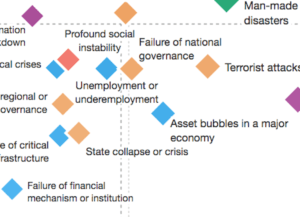
If you are looking for some added insight on the likelihood and impact of global risks as part of conducting your periodic risk assessment, a new tool from the World Economic Forum may provide some assistance.
The organization, known for its annual conference in Davos, Switzerland, which concluded last week, recently issued a “Global Risks Landscape 2018” report, which highlights the top risks global organizations face and mapped several risks on a likelihood and impact quadrant graph.
Among those risks that World Economic Forum researchers consider to be high in the likelihood of occurring, as well as having the potential for a large impact, are extreme weather events and other natural disasters, failure to address climate change, and cyber-attacks. Other “high-likelihood risks,” but those that would have a lower impact include data fraud or theft, asset bubbles, and illicit trade.
High Impact, High Likelihood
-Extreme weather events
-Natural disasters
-Failure to address climate change
-Water Crises
-Cyber-attacks
High Impact, Low Likelihood
-Weapons of mass destruction
-Food crises
-Spread of infectious diseases
-Critical infrastructure breakdown
Low Impact, High Likelihood
-Illicit trade
-Failure of urban planning
-Asset bubbles
-Data theft or fraud
Low Impact, Low Likelihood
-Unmanageable inflation
-Deflation
-Adverse effects of technology advances
-Energy price shocks
“I remain optimistic about the future, yet the risks to our world are increasing not reducing,” wrote Alison Martin, group chief risk officer at Zurich Insurance Group, in an article on the report. “They are systemic in nature and require a collective will to address them. Unfortunately, this is happening at exactly the time that nationalism, protectionism and populism are rising, and rules-based multilateralism is declining,” she wrote.
The map groups risks into categories, such as economic, environmental, geopolitical, and technological, and tracks movement in the perception of such risks over time. For the full map and other findings of the report, view the risk landscape chart. ![]()

